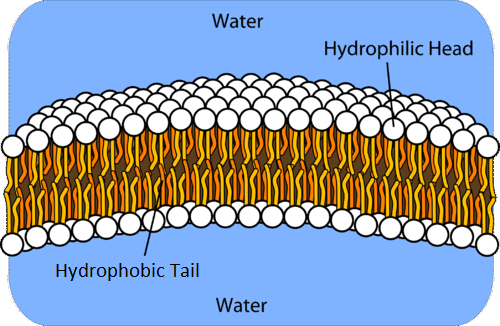14.3: Phospholipids in Cell Membranes
- Page ID
- 58858
Learning Outcomes
- Describe the structure of a phospholipid.
- Identify the polar (hydrophilic) and nonpolar (hydrophobic) regions of a phospholipid.
- Explain how the phospholipid molecules form the bilayer of the cell membrane.
When you go to the dentist to get a tooth pulled, you really do not want to feel any pain. The dentist injects an anesthetic into your gum and it eventually becomes numb. One theory as to why anesthetics work deals with the movement of ions across the cell membrane. The anesthetic gets into the membrane structure and causes shifts in how ions move across the membrane. If ion movement is disrupted, nerve impulses will not be transmitted and you will not sense pain - at least not until the anesthetic wears off.
Phospholipids
A phospholipid is a lipid that contains a phosphate group and is a major component of cell membranes. A phospholipid consists of a hydrophilic (water-loving) head and hydrophobic (water-fearing) tail (see figure below). The phospholipid is essentially a triglyceride in which a fatty acid has been replaced by a phosphate group of some sort.
Following the rule of "like dissolves like", the hydrophilic head of the phospholipid molecule dissolves readily in water. The long fatty acid chains of a phospholipid are nonpolar and thus avoid water because of their insolubility. In water, phospholipids spontaneously form a double layer called a lipid bilayer in which the hydrophobic tails of phospholipid molecules are sandwiched between two layers of hydrophilic heads (see figure below). In this way, only the heads of the molecules are exposed to the water, while the hydrophobic tails interact only with each other.

Phospholipid bilayers are critical components of cell membranes. The lipid bilayer acts as a barrier to the passage of molecules and ions into and out of the cell. However, an important function of the cell membrane is to allow selective passage of certain substances into and out of cells. This is accomplished by the embedding of various protein molecules in and through the lipid bilayer (see figure below). These proteins form channels through which certain specific ions and molecules are able to move. Many membrane proteins also contain attached carbohydrates on the outside of the lipid bilayer, allowing it to form hydrogen bonds with water.
Contributors and Attributions
Allison Soult, Ph.D. (Department of Chemistry, University of Kentucky)

